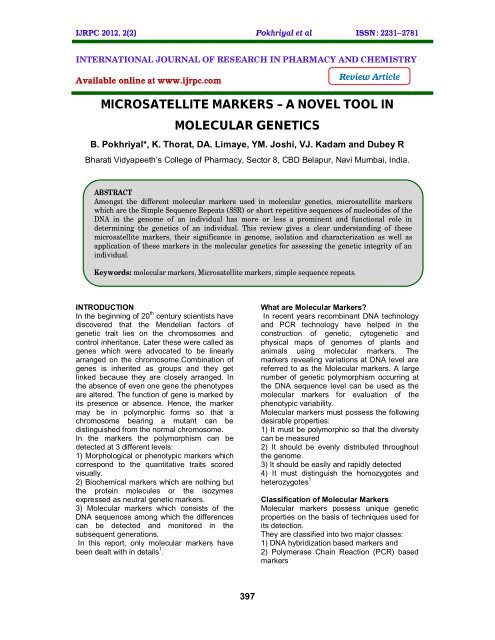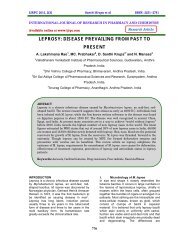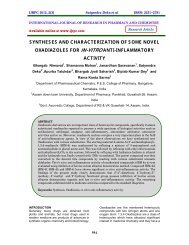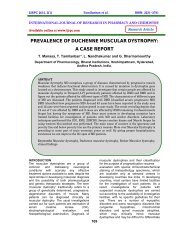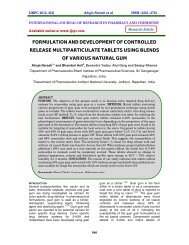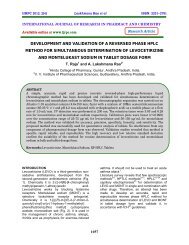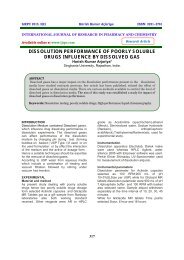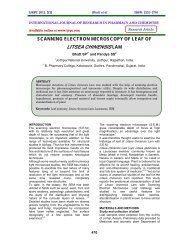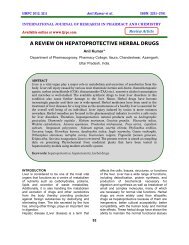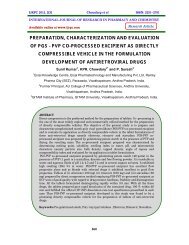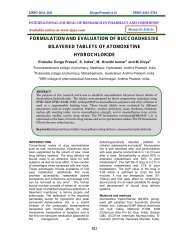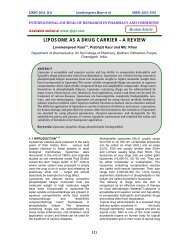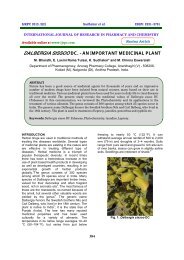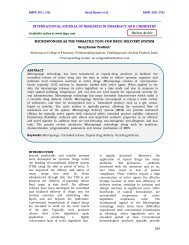microsatellite markers – a novel tool in molecular genetics - ijrpc
microsatellite markers – a novel tool in molecular genetics - ijrpc
microsatellite markers – a novel tool in molecular genetics - ijrpc
You also want an ePaper? Increase the reach of your titles
YUMPU automatically turns print PDFs into web optimized ePapers that Google loves.
IJRPC 2012, 2(2) Pokhriyal et al ISSN: 22312781<br />
INTERNATIONAL JOURNAL OF RESEARCH IN PHARMACY AND CHEMISTRY<br />
Available onl<strong>in</strong>e at www.<strong>ijrpc</strong>.com<br />
Review Article<br />
MICROSATELLITE MARKERS <strong>–</strong> A NOVEL TOOL IN<br />
MOLECULAR GENETICS<br />
B. Pokhriyal*, K. Thorat, DA. Limaye, YM. Joshi, VJ. Kadam and Dubey R<br />
Bharati Vidyapeeth’s College of Pharmacy, Sector 8, CBD Belapur, Navi Mumbai, India.<br />
ABSTRACT<br />
Amongst the different <strong>molecular</strong> <strong>markers</strong> used <strong>in</strong> <strong>molecular</strong> <strong>genetics</strong>, <strong>microsatellite</strong> <strong>markers</strong><br />
which are the Simple Sequence Repeats (SSR) or short repetitive sequences of nucleotides of the<br />
DNA <strong>in</strong> the genome of an <strong>in</strong>dividual has more or less a prom<strong>in</strong>ent and functional role <strong>in</strong><br />
determ<strong>in</strong><strong>in</strong>g the <strong>genetics</strong> of an <strong>in</strong>dividual. This review gives a clear understand<strong>in</strong>g of these<br />
<strong>microsatellite</strong> <strong>markers</strong>, their significance <strong>in</strong> genome, isolation and characterization as well as<br />
application of these <strong>markers</strong> <strong>in</strong> the <strong>molecular</strong> <strong>genetics</strong> for assess<strong>in</strong>g the genetic <strong>in</strong>tegrity of an<br />
<strong>in</strong>dividual.<br />
Keywords: <strong>molecular</strong> <strong>markers</strong>, Microsatellite <strong>markers</strong>, simple sequence repeats.<br />
INTRODUCTION<br />
In the beg<strong>in</strong>n<strong>in</strong>g of 20 th century scientists have<br />
discovered that the Mendelian factors of<br />
genetic trait lies on the chromosomes and<br />
control <strong>in</strong>heritance. Later these were called as<br />
genes which were advocated to be l<strong>in</strong>early<br />
arranged on the chromosome.Comb<strong>in</strong>ation of<br />
genes is <strong>in</strong>herited as groups and they get<br />
l<strong>in</strong>ked because they are closely arranged. In<br />
the absence of even one gene the phenotypes<br />
are altered. The function of gene is marked by<br />
its presence or absence. Hence, the marker<br />
may be <strong>in</strong> polymorphic forms so that a<br />
chromosome bear<strong>in</strong>g a mutant can be<br />
dist<strong>in</strong>guished from the normal chromosome.<br />
In the <strong>markers</strong> the polymorphism can be<br />
detected at 3 different levels:<br />
1) Morphological or phenotypic <strong>markers</strong> which<br />
correspond to the quantitative traits scored<br />
visually.<br />
2) Biochemical <strong>markers</strong> which are noth<strong>in</strong>g but<br />
the prote<strong>in</strong> molecules or the isozymes<br />
expressed as neutral genetic <strong>markers</strong>.<br />
3) Molecular <strong>markers</strong> which consists of the<br />
DNA sequences among which the differences<br />
can be detected and monitored <strong>in</strong> the<br />
subsequent generations.<br />
In this report, only <strong>molecular</strong> <strong>markers</strong> have<br />
been dealt with <strong>in</strong> details 1 .<br />
What are Molecular Markers?<br />
In recent years recomb<strong>in</strong>ant DNA technology<br />
and PCR technology have helped <strong>in</strong> the<br />
construction of genetic, cytogenetic and<br />
physical maps of genomes of plants and<br />
animals us<strong>in</strong>g <strong>molecular</strong> <strong>markers</strong>. The<br />
<strong>markers</strong> reveal<strong>in</strong>g variations at DNA level are<br />
referred to as the Molecular <strong>markers</strong>. A large<br />
number of genetic polymorphism occurr<strong>in</strong>g at<br />
the DNA sequence level can be used as the<br />
<strong>molecular</strong> <strong>markers</strong> for evaluation of the<br />
phenotypic variability.<br />
Molecular <strong>markers</strong> must possess the follow<strong>in</strong>g<br />
desirable properties:<br />
1) It must be polymorphic so that the diversity<br />
can be measured<br />
2) It should be evenly distributed throughout<br />
the genome.<br />
3) It should be easily and rapidly detected<br />
4) It must dist<strong>in</strong>guish the homozygotes and<br />
heterozygotes 1<br />
Classification of Molecular Markers<br />
Molecular <strong>markers</strong> possess unique genetic<br />
properties on the basis of techniques used for<br />
its detection.<br />
They are classified <strong>in</strong>to two major classes:<br />
1) DNA hybridization based <strong>markers</strong> and<br />
2) Polymerase Cha<strong>in</strong> Reaction (PCR) based<br />
<strong>markers</strong><br />
397
IJRPC 2012, 2(2) Pokhriyal et al ISSN: 22312781<br />
1) DNA hybridization based <strong>markers</strong><br />
The DNA piece can be cloned, and allowed to<br />
hybridize with the genomic DNA which can be<br />
detected. Marker-based DNA hybridization has<br />
been widely used but the major limitation of<br />
this approach is that it requires large quantities<br />
of DNA and the use of radioactive labeled<br />
probes.<br />
This method basically <strong>in</strong>volves the follow<strong>in</strong>g<br />
steps:<br />
1) Isolation of genomic DNA,<br />
2) Its digestion by the restriction enzymes,<br />
3) Separation by gel electrophoresis and<br />
then<br />
4) Hybridization by <strong>in</strong>cubat<strong>in</strong>g with cloned<br />
and labeled probes.<br />
2) PCR based <strong>markers</strong><br />
Polymerase Cha<strong>in</strong> Reaction (PCR) is a <strong>novel</strong><br />
technique for the amplification of the selected<br />
regions of the DNA. The advantage with PCR<br />
is that even a m<strong>in</strong>ute quantity of DNA can be<br />
amplified to a large extent and hence it<br />
requires only a small quantity of DNA to start<br />
with.<br />
PCR-based <strong>markers</strong> may be divided <strong>in</strong>to two<br />
types:<br />
1) Locus non-specific <strong>markers</strong> :<br />
e.g. a) Random amplified polymorphic DNA<br />
(RAPD);<br />
b) Amplified fragment length polymorphism<br />
(AFLP).<br />
S<strong>in</strong>ce they are locus nonspecific they doesn’t<br />
give the relevant and precise <strong>in</strong>formation<br />
about the genome and the genes and the<br />
pattern of their occurrence and <strong>in</strong>heritance.<br />
Hence, the locus specific <strong>markers</strong> are more<br />
preferred.<br />
2) Locus specific <strong>markers</strong> :<br />
e.g. a) Simple sequence repeats (SSR);<br />
b) S<strong>in</strong>gle nucleotide polymorphism (SNP).<br />
Among the segregat<strong>in</strong>g populations, the<br />
phylogenetic <strong>markers</strong> are very useful for<br />
mapp<strong>in</strong>g the polygenic traits as well as<br />
Mendelian traits. The most widespread among<br />
the polygenic <strong>markers</strong> are the Variable<br />
number of tandem repeats (VNTRs) or<br />
Microsatellites. The locus-specific probe fails<br />
to cover it and shows the highly polyallelic<br />
fragment length variation. For e.g. the tandem<br />
repeat loci associated with rRNA genes which<br />
are concentrated at nucleolar organiz<strong>in</strong>g<br />
regions (NORs) of certa<strong>in</strong> chromosomes of an<br />
<strong>in</strong>dividual. Similarly, most VNTRs loci get<br />
centered <strong>in</strong> pro-term<strong>in</strong>al regions of human<br />
chromosomes. Therefore, the desired density<br />
of <strong>markers</strong> is not provided. This difficulty is<br />
overcome <strong>in</strong> Microsatellite or SSR (Simple<br />
Sequence Repeats) loci 2 .<br />
What are Microsatellites?<br />
The term Microsatellite was first co<strong>in</strong>ed by Lit<br />
and Lutty. These are also known as the<br />
Simple sequence repeat (SSR) or Short<br />
tandem repeat (STR). These are the stretches<br />
of DNA, consist<strong>in</strong>g of tandemly repeat<strong>in</strong>g<br />
mono-, di-, tri-, tetra- and penta- nucleotide<br />
units, which are arranged throughout the<br />
genomes of most eukaryotic species. For<br />
example,<br />
AAAAAAAAAAA would be referred to as (A) 11<br />
GTGTGTGTGTGT would be referred to as<br />
(GT) 6<br />
ACTCACTCACTCACTC would be referred to<br />
as (ACTC) 4<br />
They are often represented as (CA) n repeat,<br />
where n is variable between alleles and CA is<br />
the most commonly found repeated units of<br />
cytos<strong>in</strong>e <strong>–</strong> aden<strong>in</strong>e pair <strong>in</strong> the human genome<br />
.The existence of d<strong>in</strong>ucleotide repeats- poly<br />
(C-A), poly (G-T) (i.e. an alternat<strong>in</strong>g sequence<br />
of cytos<strong>in</strong>e and aden<strong>in</strong>e, with on the opposite<br />
strand of the DNA molecule, alternat<strong>in</strong>g<br />
guan<strong>in</strong>e and thym<strong>in</strong>e) was first documented<br />
almost 15 years ago by Hamada and<br />
colleagues. Subsequent studies by Tautz and<br />
Renz have confirmed both the abundance and<br />
ubiquity of <strong>microsatellite</strong>s <strong>in</strong> eukaryotes which<br />
are <strong>in</strong>herited <strong>in</strong> a Mendelian fashion 3 .<br />
Why Microsatellite Markers are Preferred<br />
over other Molecular Markers? 3<br />
There are several widely used marker types<br />
available for <strong>molecular</strong> ecology studies, and<br />
many questions can be addressed with more<br />
than one type of marker. Microsatellites are of<br />
particular <strong>in</strong>terest to ecologists because they<br />
are one of the few <strong>molecular</strong> <strong>markers</strong> that<br />
allow researchers <strong>in</strong>sight <strong>in</strong>to f<strong>in</strong>e-scale<br />
ecological questions. Regardless of the<br />
question, a <strong>molecular</strong> marker must<br />
fundamentally be selectively neutral and follow<br />
Mendelian <strong>in</strong>heritance <strong>in</strong> order to be used as a<br />
<strong>tool</strong> for detect<strong>in</strong>g demographic patterns, and<br />
these traits should always be confirmed for<br />
any marker type. The desirable traits of<br />
<strong>microsatellite</strong>s compared with other marker<br />
types such as allozymes, amplified fragment<br />
length polymorphisms(AFLP), sequenced loci<br />
and s<strong>in</strong>gle nuclear polymorphisms (SNP),<br />
focused on both practicalities and ecological<br />
considerations are as under<br />
1) Easy sample preparation 3<br />
An ideal marker allows the use of small tissue<br />
samples which are easily preserved for future<br />
use. In contrast to allozyme methods, DNAbased<br />
techniques, such as <strong>microsatellite</strong>s, use<br />
PCR to amplify the marker of <strong>in</strong>terest from a<br />
m<strong>in</strong>ute tissue sample. The stability of DNA<br />
398
IJRPC 2012, 2(2) Pokhriyal et al ISSN: 22312781<br />
compared with enzymes allows the use of<br />
simple tissue preservatives (such as 95%<br />
ethanol) for storage. In addition, because<br />
<strong>microsatellite</strong>s are usually shorter <strong>in</strong> length<br />
than sequenced loci (100<strong>–</strong>300 vs. 500<strong>–</strong>1500<br />
base pairs) they can still be amplified with<br />
PCR despite some DNA degradation (Taberlet<br />
et al. 1999) [5] . As DNA degrades, it breaks <strong>in</strong>to<br />
smaller pieces and the chance of successfully<br />
amplify<strong>in</strong>g a long segment is proportional to its<br />
length (Frantzen et al. 1998) [6] . This trait allows<br />
<strong>microsatellite</strong>s to be used with fast and cheap<br />
DNA extraction methods, with ancient DNA, or<br />
DNA from hair and faecal samples used <strong>in</strong><br />
non-<strong>in</strong>vasive sampl<strong>in</strong>g (Taberlet et al.<br />
1999).Furthermore, because <strong>microsatellite</strong>s<br />
are species-specific, cross-contam<strong>in</strong>ation by<br />
non-target organisms is much less of a<br />
problem compared with techniques that<br />
employ universal primers (i.e. primers that will<br />
amplify DNA from any species), such as<br />
AFLP. This feature is of particular importance<br />
when work<strong>in</strong>g with faecal samples or species,<br />
such as scleract<strong>in</strong>ian corals, <strong>in</strong> which<br />
endosymbiont contam<strong>in</strong>ation is practically<br />
unavoidable.<br />
2) High <strong>in</strong>formation content 3<br />
Each marker locus can be considered a<br />
sample of the genome. Because of<br />
recomb<strong>in</strong>ation, selection and genetic drift,<br />
different genes and different regions of the<br />
genome have slightly different genealogical<br />
histories. Rely<strong>in</strong>g on a s<strong>in</strong>gle locus to estimate<br />
ecological traits from genetic data creates a<br />
high rate of sampl<strong>in</strong>g error. Thus, tak<strong>in</strong>g<br />
multiple samples of the genome by comb<strong>in</strong><strong>in</strong>g<br />
the results from many loci provides a more<br />
precise and statistically powerful way of<br />
compar<strong>in</strong>g populations and <strong>in</strong>dividuals.<br />
Furthermore, statistical approaches to the<br />
questions of most <strong>in</strong>terest to ecologists often<br />
require multiple, comparable loci ( Pearse &<br />
Crandall 2004). Although AFLP, allozymes<br />
and random amplified polymorphic DNA<br />
(RAPD) techniques are also multilocus, none<br />
of them have the resolution and power of a<br />
multilocus <strong>microsatellite</strong> study (but for dist<strong>in</strong>ct<br />
reasons; see Sunnucks 2000). While AFLP<br />
<strong>markers</strong> can be a good alternative choice to<br />
<strong>microsatellite</strong>s (Bensch & Akesson 2005).<br />
Gerber et al. (2000) showed that 159 AFLP<br />
loci provided slightly less power to determ<strong>in</strong>e<br />
paternity than six polymorphic <strong>microsatellite</strong><br />
<strong>markers</strong>. Sequenc<strong>in</strong>g technology has<br />
advanced rapidly, but its cost still prohibits the<br />
duplication or triplication of workload by us<strong>in</strong>g<br />
multiple <strong>in</strong>dependent gene sequences <strong>in</strong><br />
parallel (Zhang & Hewitt 2003). SNP <strong>markers</strong><br />
hold great promise for future studies but their<br />
use <strong>in</strong> non-model organisms is still nascent<br />
(Mor<strong>in</strong> et al. 2004).<br />
3) Co-dom<strong>in</strong>ant <strong>markers</strong> 3<br />
Microsatellites have become so popular<br />
because they are s<strong>in</strong>gle locus, co-dom<strong>in</strong>ant<br />
<strong>markers</strong> for which many loci can be efficiently<br />
comb<strong>in</strong>ed <strong>in</strong> the genotyp<strong>in</strong>g process to provide<br />
fast and <strong>in</strong>expensive replicated sampl<strong>in</strong>g of<br />
the genome. Microsatellite <strong>markers</strong> generally<br />
have high-mutation rates result<strong>in</strong>g <strong>in</strong> high<br />
stand<strong>in</strong>g allelic diversity. In species for which<br />
populations are small or recently bottlenecked,<br />
<strong>markers</strong> with lower mutation rates, such as<br />
allozymes, may be largely <strong>in</strong>variant and only<br />
loci with the highest mutation rates are likely to<br />
be <strong>in</strong>formative (Hedrick 1999). A slow<br />
mutational process allows the signature of<br />
events <strong>in</strong> the distant past to persist longer.<br />
Thus, the selection of loci with high or low<br />
allelic diversity will depend on the question of<br />
<strong>in</strong>terest. For example, if one is <strong>in</strong>terested <strong>in</strong> a<br />
potential historical barrier to gene flow or<br />
trac<strong>in</strong>g the recolonization of territory s<strong>in</strong>ce the<br />
last ice age, <strong>markers</strong> with lower mutational<br />
rates are likely to be the most <strong>in</strong>formative. [3]<br />
Attributes of Microsatellites as Genetic<br />
<strong>markers</strong><br />
Some of the significant attributes of<br />
<strong>microsatellite</strong> <strong>markers</strong> which they possess are<br />
as follows:<br />
1) Locus-specific <strong>in</strong> nature; <strong>in</strong> contrast to<br />
multi-locus <strong>markers</strong> such as m<strong>in</strong>isatellites<br />
or Random amplified<br />
polymorphic DNA (RAPDs)<br />
2) Co-dom<strong>in</strong>ant transmission and therefore<br />
the heterozygotes can be dist<strong>in</strong>guished<br />
from homozygotes, <strong>in</strong> contrast to<br />
Random amplified polymorphic DNA<br />
(RAPD); Amplified fragment length<br />
polymorphism (AFLP) which are b<strong>in</strong>ary <strong>in</strong><br />
nature<br />
3) Highly polymorphic and hyper-variable<br />
4) High <strong>in</strong>formation content and provides<br />
considerable pattern<br />
5) Relative abundance with uniform genome<br />
coverage<br />
6) Higher mutation rate than standard<br />
sequences (up to<br />
0.001gamates/generation)<br />
7) High probability of back mutation 4 .<br />
399
IJRPC 2012, 2(2) Pokhriyal et al ISSN: 22312781<br />
Significance of Microsatellites In Genome 4<br />
As there are often many alleles present at a<br />
<strong>microsatellite</strong> locus, genotypes with<strong>in</strong><br />
pedigrees are often fully <strong>in</strong>formative, <strong>in</strong> that<br />
the progenitor of a particular allele can often<br />
be identified. In this way, <strong>microsatellite</strong>s can<br />
be used for determ<strong>in</strong><strong>in</strong>g paternity, population<br />
genetic studies and recomb<strong>in</strong>ation mapp<strong>in</strong>g. It<br />
is also the only <strong>molecular</strong> marker to provide<br />
clues about which alleles are more closely<br />
related. Also, these <strong>markers</strong> often present high<br />
levels of <strong>in</strong>ter- and <strong>in</strong>tra-specific<br />
polymorphism, particularly when tandem<br />
repeats number are 10 or greater.<br />
The Significance of Microsatellite <strong>markers</strong> are<br />
as under:<br />
Microsatellites determ<strong>in</strong>e the genotype<br />
of an <strong>in</strong>dividual. They usually don't have any<br />
measurable effect on phenotype, and when<br />
they do mutate, may cause a change <strong>in</strong> the<br />
genotype of an <strong>in</strong>dividual.<br />
Microsatellites may act as a marker for<br />
some genetic diseases. They were previously<br />
considered to be as the "Junk" DNA which is<br />
generally found on the Non-cod<strong>in</strong>g regions of<br />
DNA and the variation is mostly neutral.In<br />
humans, 90% of known <strong>microsatellite</strong>s are<br />
found <strong>in</strong> non-cod<strong>in</strong>g regions of the<br />
genome. When found <strong>in</strong> human cod<strong>in</strong>g<br />
regions, <strong>microsatellite</strong>s are known to cause<br />
disease. Interest<strong>in</strong>gly, when found <strong>in</strong> cod<strong>in</strong>g<br />
regions, <strong>microsatellite</strong>s are usually tr<strong>in</strong>ucleotide<br />
repeats. One possible explanation<br />
is that any other type of nucleotide repeat<br />
would be too detrimental to the cod<strong>in</strong>g region,<br />
because it would cause a frame-shift mutation.<br />
Microsatellites provide a necessary<br />
source of genetic variation. The variation <strong>in</strong><br />
<strong>microsatellite</strong> alleles <strong>in</strong> cod<strong>in</strong>g regions is<br />
thought to be the cause of adaptation <strong>in</strong><br />
different environments. In other words, a short<br />
allele may be adaptive <strong>in</strong> one environment,<br />
and a long allele with many repeats may be<br />
adaptive <strong>in</strong> a different environment.<br />
Microsatellite variation may be a way<br />
to compensate for loss of genetic variability<br />
due to genetic drift and selection. Thus hav<strong>in</strong>g<br />
variation with<strong>in</strong> the population would ensure<br />
the survival of the population <strong>in</strong> vary<strong>in</strong>g<br />
environment.<br />
Microsatellites may help regulate gene<br />
expression and prote<strong>in</strong> function.Kashi and<br />
Soller (1999) have suggested that<br />
<strong>microsatellite</strong>s may have regulatory roles <strong>in</strong><br />
gene expression. They are systematically<br />
found near cod<strong>in</strong>g regions. Variation <strong>in</strong><br />
<strong>microsatellite</strong> alleles have been shown to be<br />
associated with quantitative variation <strong>in</strong> prote<strong>in</strong><br />
function and gene activity.<br />
Mutation <strong>in</strong> Microsatellites 5<br />
Microsatellites owe their variability to an<br />
<strong>in</strong>creased rate of mutation compared to other<br />
neutral regions of DNA. The size of the repeat<br />
unit, the number of repeats and the presence<br />
of variant repeats are all factors, as well as the<br />
frequency of transcription <strong>in</strong> the area of the<br />
DNA repeat. Interruption of <strong>microsatellite</strong>s,<br />
perhaps due to mutation, can result <strong>in</strong> reduced<br />
polymorphism. The reason seems to be that<br />
their mutations occur <strong>in</strong> a fashion very different<br />
from that of "classical" po<strong>in</strong>t mutations (where<br />
a substitution of one nucleotide to another<br />
occurs, such as a G substitut<strong>in</strong>g for a C).<br />
The mutation process <strong>in</strong> <strong>microsatellite</strong>s<br />
occurs through what is known as slippage<br />
replication. If we consider the repeat units<br />
(e.g., an AC d<strong>in</strong>ucleotide repeat) as beads on<br />
a cha<strong>in</strong>, we can imag<strong>in</strong>e that dur<strong>in</strong>g replication<br />
two strands could slip relative positions a bit,<br />
but still manage to get the zipper go<strong>in</strong>g down<br />
the beads. One strand or the other could then<br />
be lengthened or shortened by addition or<br />
excision of nucleotides. The result will be a<br />
<strong>novel</strong> "mutation" that comprises a repeat unit<br />
that is one bead longer or shorter than the<br />
orig<strong>in</strong>al.<br />
It is estimated that <strong>microsatellite</strong>s mutate 100<br />
to 10,000 times as fast as base pair<br />
substitutions. This makes <strong>microsatellite</strong>s<br />
useful for study<strong>in</strong>g evolution over short time<br />
spans, whereas base pair substitutions are<br />
more useful for study<strong>in</strong>g evolution over long<br />
time spans (millions of years). Microsatellite<br />
alleles mutate over time. In a population, there<br />
may exist many alleles of a s<strong>in</strong>gle<br />
<strong>microsatellite</strong> locus. Microsatellite alleles differ<br />
<strong>in</strong> the number of repeats. For example, one<br />
allele may have 7 repeats of a CT motif, and<br />
another allele may have 8 repeats. In a<br />
population, there may exist many alleles at a<br />
s<strong>in</strong>gle locus, with each allele hav<strong>in</strong>g a different<br />
length. An <strong>in</strong>dividual who is homozygous for a<br />
locus will have the same number of repeats on<br />
both chromosomes, whereas a heterozygous<br />
<strong>in</strong>dividual will have different numbers of<br />
repeats on the two chromosomes.<br />
The regions surround<strong>in</strong>g the <strong>microsatellite</strong><br />
locus, called the flank<strong>in</strong>g regions, may still<br />
have the same sequence. This is important<br />
because the flank<strong>in</strong>g regions can therefore be<br />
used as PCR primers when amplify<strong>in</strong>g<br />
<strong>microsatellite</strong> loci, and can be conserved<br />
across genera or sometimes even<br />
families. Below, the two l<strong>in</strong>es represent the<br />
sequences on two homologous chromosomes<br />
<strong>in</strong> a diploid organism.<br />
400
IJRPC 2012, 2(2) Pokhriyal et al ISSN: 22312781<br />
Homozygous<br />
(Both strands have 7 CT repeats)<br />
…CGTAGCCTTGCATCCTTCTCTCTCTCTCT<br />
CTATCGGTACTACGTGG…<br />
…CGTAGCCTTGCATCCTTCTCTCTCTCTCT<br />
CTATCGGTACTACGTGG…<br />
5’ flank<strong>in</strong>g region <strong>microsatellite</strong> locus 3’ flank<strong>in</strong>g region<br />
Heterozygous<br />
(One strand has 7 repeats, and the other has<br />
8 repeats)<br />
…CGTAGCCTTGCATCCTTCTCTCTCTCTCT<br />
CTATCGGTACTACGTGG…<br />
…CGTAGCCTTGCATCCTTCTCTCTCTCTCT<br />
CTCTATCGGTACTACGTGG…<br />
Microsatellites are useful genetic <strong>markers</strong><br />
because they tend to be highly polymorphic. It<br />
is not uncommon to have human<br />
<strong>microsatellite</strong>s with 20 or more alleles with<br />
heterozygosities. [8]<br />
Microsatellites generally tend to occur <strong>in</strong> noncod<strong>in</strong>g<br />
regions of the DNA although a few<br />
human genetic disorders are caused by (tr<strong>in</strong>ucleotide)<br />
<strong>microsatellite</strong> regions <strong>in</strong> cod<strong>in</strong>g<br />
regions. On each side of the repeat unit<br />
are flank<strong>in</strong>g regions that consist of "unordered"<br />
DNA. The flank<strong>in</strong>g regions are critical because<br />
they allow us to develop locus-specific primers<br />
to amplify the <strong>microsatellite</strong>s with PCR<br />
(polymerase cha<strong>in</strong> reaction). That is, given a<br />
stretch of unordered DNA 30-50 base pairs<br />
(bp) long, the probability of f<strong>in</strong>d<strong>in</strong>g that<br />
particular stretch more than once <strong>in</strong> the<br />
genome becomes vanish<strong>in</strong>gly small. This<br />
comb<strong>in</strong>ation of widely occurr<strong>in</strong>g repeat units<br />
and locus-specific flank<strong>in</strong>g regions are a part<br />
of strategy for f<strong>in</strong>d<strong>in</strong>g and develop<strong>in</strong>g<br />
<strong>microsatellite</strong> primers. The primers for PCR<br />
will be sequences from these unique flank<strong>in</strong>g<br />
regions. By hav<strong>in</strong>g a forward and a reverse<br />
primer on each side of the <strong>microsatellite</strong>, we<br />
will be able to amplify a fairly short (100 to 500<br />
bp, where bp means base pairs) locus-specific<br />
<strong>microsatellite</strong> region.<br />
There are two hypotheses that expla<strong>in</strong> how<br />
<strong>microsatellite</strong>s mutate 5<br />
1. “Polymerase slippage” or “slippedstrand<br />
mispair<strong>in</strong>g”: When the DNA<br />
replicates, the polymerase loses track of its<br />
place, and either leaves out repeat units or<br />
adds too many repeat units. The result is that<br />
the new strand has a different number of<br />
repeats as the parent strand. This is thought to<br />
expla<strong>in</strong> small changes <strong>in</strong> numbers of repeats.<br />
It also expla<strong>in</strong>s how <strong>microsatellite</strong> loci could be<br />
generated <strong>in</strong> the first place; it is likely that<br />
sequences <strong>in</strong>clud<strong>in</strong>g two or three repeats are<br />
randomly distributed throughout the<br />
genome. Slippage could then amplify these<br />
401<br />
short repeat sequences <strong>in</strong>to many repeats<br />
over successive generations. Certa<strong>in</strong>ly, the<br />
effectiveness of the mismatch repair system<br />
would also play an important role <strong>in</strong><br />
<strong>microsatellite</strong> mutation rate.<br />
2. Unequal cross<strong>in</strong>g-over dur<strong>in</strong>g<br />
meiosis:This is thought to expla<strong>in</strong> more<br />
drastic changes <strong>in</strong> numbers of repeats. In the<br />
diagram below, chromosome A obta<strong>in</strong>ed too<br />
many repeats dur<strong>in</strong>g cross<strong>in</strong>g-over and<br />
chromosome B obta<strong>in</strong>ed too few repeats. 9<br />
Model for Microsatellite Mutation 5<br />
Many models have been proposed to expla<strong>in</strong><br />
the mutation <strong>in</strong> <strong>microsatellite</strong>s but due to some<br />
or the other limitations or unexpla<strong>in</strong>ed facts<br />
they have been discarded. So a model is<br />
proposed which expla<strong>in</strong>s most of the<br />
mutational mechanisms and facts and<br />
uncerta<strong>in</strong>ties <strong>in</strong> <strong>microsatellite</strong> mutation are<br />
been described <strong>in</strong> stepwise mutation model as<br />
follows:<br />
Stepwise Mutation Model (SMM)<br />
The idea that add<strong>in</strong>g or subtract<strong>in</strong>g one repeat<br />
is likely easier than add<strong>in</strong>g or subtract<strong>in</strong>g two<br />
or more beads is the basis for us<strong>in</strong>g<br />
the Stepwise Mutation Model (SMM). This<br />
model holds that when <strong>microsatellite</strong>s mutate,<br />
they only ga<strong>in</strong> or lose one repeat. This implies<br />
that two alleles that differ by one repeat are<br />
more closely related (have a more recent<br />
common ancestor) than alleles that differ by<br />
many repeats. In other words, size matters<br />
when do<strong>in</strong>g statistical tests of population substructur<strong>in</strong>g.<br />
An advantage of the SMM is that<br />
the difference <strong>in</strong> size conveys additional<br />
<strong>in</strong>formation about the phylogeny of alleles. The<br />
SMM is generally the preferred model when<br />
calculat<strong>in</strong>g relatedness between <strong>in</strong>dividuals<br />
and population sub-structur<strong>in</strong>g, although there<br />
is the problem of homoplasy.<br />
Problem: Homoplasy<br />
Pretend that you are study<strong>in</strong>g a population and<br />
you f<strong>in</strong>d four <strong>in</strong>dividuals. Three of them have<br />
the same genotype, and one is different. This<br />
would <strong>in</strong>dicate that the three with the same<br />
genotype are more closely related to each<br />
other than they are to the other. However, this<br />
is not necessarily the case. To understand<br />
why, study the phylogeny below. Asterisks<br />
<strong>in</strong>dicate <strong>microsatellite</strong> mutations.
IJRPC 2012, 2(2) Pokhriyal et al ISSN: 22312781<br />
In the fig; population 1 gave rise to two<br />
populations, 2 and 3.<br />
In population 3, there was a stepwise<br />
mutation, so that now there are four CAG<br />
repeats <strong>in</strong>stead of three.<br />
Population 3 gave rise to two more<br />
populations, 6 and 7.<br />
Population 6 lost a repeat, so now it has three<br />
CAG repeats.<br />
The problem is that populations 4, 5,<br />
and 6 have the same allele at this<br />
<strong>microsatellite</strong> locus, yet they have different<br />
evolutionary histories.We can say that their<br />
alleles are identical <strong>in</strong> state but not by descent.<br />
If a scientist were only exam<strong>in</strong><strong>in</strong>g this one<br />
locus, he/she would mistakenly conclude that<br />
population 6 is more closely related to<br />
populations 4 and 5 than it is to 7.<br />
This phenomenon, when two alleles are<br />
identical <strong>in</strong> state but not identical by descent,<br />
is known as homoplasy.<br />
In population studies, homoplasy can lead to<br />
underestimates of divergence. The only way to<br />
detect homoplasy would be to exam<strong>in</strong>e many<br />
other loci.<br />
Still, homoplasy is thought to have little effect<br />
on populations over a short period of time<br />
(hundreds of generations), and stepwise<br />
mutation model is still the preferred model. [9]<br />
Isolation, Development and<br />
Characterization of Microsatellites 6<br />
Develop<strong>in</strong>g new <strong>microsatellite</strong> <strong>markers</strong> based<br />
on the enrichment technique and primer<br />
optimization steps.<br />
A. Extract DNA from a s<strong>in</strong>gle tissue sample.<br />
B. Create a DNA library:<br />
1. Cut the genome <strong>in</strong>to 500 bp fragments<br />
pieces with a restriction enzyme digest.<br />
2. Attach ‘l<strong>in</strong>ker’ DNA to the ends of each<br />
fragment <strong>–</strong> l<strong>in</strong>ker DNA has a known sequence<br />
so that<br />
primers can be designed to b<strong>in</strong>d to them.<br />
3. Amplify the DNA fragments us<strong>in</strong>g primers<br />
for the l<strong>in</strong>ker ends with PCR.<br />
C. Separate out fragments with repeat<br />
sequences:<br />
1. Mix the DNA fragments with a <strong>microsatellite</strong><br />
probe (an oligonucleotide made of a<br />
repeatsequence of your choice) that can be<br />
recovered magnetically.<br />
2. Promote the hybridization of probes to any<br />
complementary repeat sequences <strong>in</strong> the DNA<br />
Fragments by heat<strong>in</strong>g to denature the DNA<br />
and cool<strong>in</strong>g slowly.<br />
3. Hold a magnet to the tube to attract the<br />
probes (now bound to the DNA), and wash<br />
away therest of the unbound DNA with a<br />
series of r<strong>in</strong>ses.<br />
D. Sequence the fragments to f<strong>in</strong>d<br />
<strong>microsatellite</strong> loci:<br />
1. Us<strong>in</strong>g primers for the l<strong>in</strong>ker DNA, amplify<br />
DNA with PCR to concentrate it.<br />
2. Clone the DNA to prepare it for sequenc<strong>in</strong>g<br />
- <strong>in</strong>sert it <strong>in</strong>to a plasmid, <strong>in</strong>oculate bacteria with<br />
the plasmid, grow the bacteria to replicate the<br />
DNA.<br />
3. Isolate the DNA from the bacteria.<br />
4. Sequence <strong>microsatellite</strong> DNA <strong>in</strong> the plasmid<br />
with primers targeted to the <strong>in</strong>sertion po<strong>in</strong>ts on<br />
the plasmid.<br />
E. Exam<strong>in</strong>e the sequences to f<strong>in</strong>d<br />
<strong>microsatellite</strong> repeats.<br />
F. Design primers for the flank<strong>in</strong>g region of the<br />
<strong>microsatellite</strong>s (with help from a primer<br />
selection software program such as Primer3<br />
which selects optimal primer sites) and have<br />
them made.<br />
G. Attempt amplification of loci with the new<br />
primers. Use a gradient of PCR conditions <strong>in</strong><br />
which the temperatures, times, magnesium<br />
and primer concentrations vary to f<strong>in</strong>d optimal<br />
conditions.<br />
H. Use gel electrophoresis to confirm the<br />
presence of PCR products. Discard primer<br />
pairs that fail to amplify after several attempts.<br />
I. Check for polymorphism by runn<strong>in</strong>g the<br />
successful primer pairs on 10-20 <strong>in</strong>dividuals.<br />
Estimate allelic diversity and heterozygosity<br />
levels. Discard <strong>in</strong>variant loci.<br />
J. Check for reliability. Rerun the successful<br />
primer pairs on the same <strong>in</strong>dividuals twice<br />
more to ensure that genotype scor<strong>in</strong>g is<br />
consistently reproducible. Discard loci with<br />
unreliable amplification.<br />
H. Order fluorescently labeled primers for the<br />
rema<strong>in</strong><strong>in</strong>g loci. Complete the full screen<strong>in</strong>g<br />
process. Discard problematic loci.<br />
K. Streaml<strong>in</strong>e the genotyp<strong>in</strong>g of the full dataset<br />
with the rema<strong>in</strong><strong>in</strong>g loci by establish<strong>in</strong>g a<br />
“multiplex” PCR protocol <strong>–</strong> primers for multiple<br />
loci (labeled with different dyes) are amplified<br />
<strong>in</strong> a s<strong>in</strong>gle PCR reaction 3 .<br />
402
IJRPC 2012, 2(2) Pokhriyal et al ISSN: 22312781<br />
403
IJRPC 2012, 2(2) Pokhriyal et al ISSN: 22312781<br />
404
IJRPC 2012, 2(2) Pokhriyal et al ISSN: 22312781<br />
6<br />
Microsatellite Genotyp<strong>in</strong>g with a DNA<br />
Sequencer<br />
A DNA sequencer is a highly precise gel<br />
electrophoresis apparatus. PCR products are<br />
loaded onto the gel and separated by size by<br />
apply<strong>in</strong>g a charge. A laser scans the gel to<br />
detect bands conta<strong>in</strong><strong>in</strong>g fluorescent dye. The<br />
primers used <strong>in</strong> the PCR reaction are tagged<br />
with different fluorescent dyes to enable this<br />
detection. The sequencer software converts<br />
the band<strong>in</strong>g pattern <strong>in</strong>to a plot with peaks<br />
correspond<strong>in</strong>g to the width and <strong>in</strong>tensity<br />
(height) of each band. The position of the peak<br />
along the x-axis corresponds to the size of the<br />
DNA product <strong>in</strong> the band measured <strong>in</strong> base<br />
pairs (BP). The height/<strong>in</strong>tensity corresponds to<br />
the concentration of the DNA product, which is<br />
a consequence of the efficiency of the<br />
amplification process <strong>in</strong> PCR. One color is<br />
used for a size standard to calibrate the band<br />
positions with the size of the DNA product. An<br />
asterisk identifies all true <strong>microsatellite</strong> alleles<br />
<strong>in</strong> the figures below.<br />
405
IJRPC 2012, 2(2) Pokhriyal et al ISSN: 22312781<br />
A<br />
B<br />
C<br />
D<br />
A) An ideal output<br />
The two alleles of this heterozygote are even<br />
<strong>in</strong> height and easy to dist<strong>in</strong>guish from the<br />
“stutter peaks” adjacent to them <strong>–</strong> dur<strong>in</strong>g PCR<br />
some products are 1, 2 or 3 repeats short due<br />
to errors <strong>in</strong> replication (similar to step-wise<br />
mutation) and show up as evenly spaced<br />
peaks with decreas<strong>in</strong>g height to the left of the<br />
true peak. Some loci show extensive stutter<strong>in</strong>g<br />
and others show virtually none. The stutter<br />
bands are useful for dist<strong>in</strong>guish<strong>in</strong>g<br />
<strong>microsatellite</strong> products from non-specific or<br />
non-target products. Notice that there are<br />
“pull-up peaks” <strong>in</strong> the green section of the<br />
spectrum. Pull-up is due primarily to spectral<br />
overlap <strong>in</strong> the emission spectra of the dyes<br />
which the sequencer records as a false peak<br />
<strong>in</strong> a different color. This is a common artifact of<br />
the DNA sequencer’s analysis process that<br />
can create confusion <strong>in</strong> some situations.<br />
B) Two examples of trickier outputs<br />
The blue genotype is a heterozygote but the 2<br />
alleles are only 1repeat different <strong>in</strong> size. This<br />
creates a characteristic pattern for loci with<br />
stutter <strong>in</strong> which the second peak is higher than<br />
the first because of the additive <strong>in</strong>tensity of the<br />
larger allele’s first stutter peak and the smaller<br />
allele’s true peak. If the first two peaks were<br />
equal <strong>in</strong> height it would be difficult to<br />
determ<strong>in</strong>e if the genotype has one or two<br />
alleles. One clue is that there are 4 stutter<br />
peaks to the right of the largest peak <strong>in</strong>stead<br />
of 3. The second locus <strong>in</strong> this plot is shown<br />
with black dye and has larger alleles. This<br />
locus has no stutter perhaps because there<br />
are few repeats so that the Taq polymerase<br />
doesn’t make stepwise errors. This genotype<br />
is also a heterozygote, but the larger allele is<br />
fa<strong>in</strong>t. Larger alleles usually show at least<br />
slightly shorter peaks because PCR is less<br />
efficient for longer products. Here, the larger<br />
allele is so small that it could be easily<br />
overlooked or mistaken for noise. If any less<br />
PCR product were loaded onto the gel it might<br />
not show up at all <strong>–</strong> <strong>in</strong> which case it would be<br />
an example of “large allele drop-out,” another<br />
common source of <strong>in</strong>flated homozygosity<br />
counts.<br />
C) More examples<br />
When multiple loci are loaded <strong>in</strong> the same gel<br />
lane for efficiency, or amplified together <strong>in</strong> one<br />
PCR “multiplex” reaction, allele peaks can<br />
overlap and be sometimes easy to miss. Here<br />
the green and blue loci share an allele size.<br />
Dist<strong>in</strong>guish<strong>in</strong>g the true alleles is made even<br />
more difficult due to the occurrence of green<br />
pull-up peaks. If the green allele product were<br />
less <strong>in</strong>tense than the blue allele product<br />
(<strong>in</strong>stead of equal as shown here), it might be<br />
mistaken for a pull up peak. Re-runn<strong>in</strong>g the<br />
green locus separately <strong>in</strong> such cases will<br />
m<strong>in</strong>imize scor<strong>in</strong>g error. Here aga<strong>in</strong>, the blue<br />
locus shows two alleles that differ by one base<br />
pair. The heights are the same because this<br />
locus does not show strong stutter. But the<br />
blue locus does show small flank<strong>in</strong>g peaks <strong>–</strong><br />
the left side is a very fa<strong>in</strong>t stutter so only the<br />
largest stutter peak is visible, and the right<br />
406
IJRPC 2012, 2(2) Pokhriyal et al ISSN: 22312781<br />
side might be an “A-Tail,” when the Taq adds<br />
an extra aden<strong>in</strong>e nucleotide onto some copies<br />
of the product, <strong>in</strong>creas<strong>in</strong>g it by 1 bp. It will not<br />
be mistaken for a <strong>microsatellite</strong> allele because<br />
an extreme height difference would not occur<br />
for 2 alleles so close <strong>in</strong> size, as their<br />
amplification efficiencies should be similar.<br />
The black locus is a homozygote. Even though<br />
there is a small black peak on the left side of<br />
the plot, a smaller allele is almost never<br />
shorter than a larger allele. An additional clue<br />
is that the larger black peak is quite fat and tall<br />
-- PCR produces approximately double the<br />
amount of product when an allele is<br />
homozygous because it does not compete for<br />
the Taq with a second allele. The purple locus<br />
represents a “split peak” problem that occurs<br />
from high rates of ATail<strong>in</strong>g by the Taq. The<br />
“+A” peaks occur for all of the stutter peaks,<br />
mak<strong>in</strong>g the scor<strong>in</strong>g difficult, especially for<br />
heterozygotes with closely sized alleles.<br />
Although the true allele is denoted here, a<br />
locus with alleles that look like the purple one<br />
would be too difficult to score reliably. Usually<br />
the problem can be corrected by add<strong>in</strong>g an<br />
extra extension step to the PCR program that<br />
gives the Taq time to add an A-Tail to all<br />
copies of the product consistently.<br />
D) Unscorable loci<br />
The blue locus is a “stegosaur” with<br />
unacceptably high stutter. The black locus has<br />
too many non-specific artifact peaks to reliably<br />
choose the <strong>microsatellite</strong> alleles. The green<br />
locus has been overloaded on the gel or has<br />
unusually high PCR product concentration and<br />
is smear<strong>in</strong>g <strong>in</strong> the lane 3 .<br />
Limitations To Utility of Microsatellites 7<br />
Microsatellites have proved to be versatile<br />
<strong>molecular</strong> <strong>markers</strong>, particularly for population<br />
analysis, but they are not without limitations.<br />
Despite many advantages, <strong>microsatellite</strong><br />
<strong>markers</strong> also have several challenges and<br />
pitfalls that at best complicate the data<br />
analysis, and at worst greatly limit their utility<br />
and confound their analysis. However, all<br />
marker types have some downsides, and the<br />
versatility of <strong>microsatellite</strong>s to address many<br />
types of ecological questions outweighs their<br />
drawbacks for many applications. Fortunately,<br />
many of the pitfalls common to <strong>microsatellite</strong><br />
<strong>markers</strong> can be avoided by careful selection of<br />
loci dur<strong>in</strong>g the isolation process. Speciesspecific<br />
marker isolation PCR-based marker<br />
analysis requires primer sequences that target<br />
the marker regions for amplification. In order to<br />
use the same primer sequence to amplify the<br />
same target from many <strong>in</strong>dividuals, the region<br />
where the primer b<strong>in</strong>ds must be identical, with<br />
few or no mutations caus<strong>in</strong>g <strong>in</strong>ter-<strong>in</strong>dividual<br />
differences. For the gene regions commonly<br />
used as sequenced <strong>markers</strong>, primer regions<br />
are highly conserved, such that they are<br />
<strong>in</strong>variant with<strong>in</strong> species and sometimes even<br />
across broad taxonomic groups. This<br />
sequence conservation necessitates only<br />
m<strong>in</strong>or work to optimize a primer set for a new<br />
species. In contrast, a given pair of<br />
<strong>microsatellite</strong> primers rarely works across<br />
broad taxonomic groups, and so primers are<br />
usually developed a new for each species<br />
(Glenn & Schable 2005). However, the<br />
process of isolat<strong>in</strong>g new <strong>microsatellite</strong> <strong>markers</strong><br />
has become faster and less expensive, which<br />
substantially reduces the failure rate and cost<br />
of new marker isolation <strong>in</strong> many cases (Glenn<br />
& Schable 2005).<br />
Some of the Major limitations <strong>in</strong> utility of<br />
<strong>microsatellite</strong>s are as follows<br />
1. Unclear mutational mechanisms 7<br />
One of the challenges currently be<strong>in</strong>g<br />
addressed by geneticists is that the mutational<br />
processes of <strong>microsatellite</strong>s can be complex<br />
(Schlo¨tterer 2000; Beck et al. 2003; Ellegren<br />
2004). For the majority of ecological<br />
applications, it is not important to know the<br />
exact mutational mechanism of each locus, as<br />
most relevant analyses are <strong>in</strong>sensitive to<br />
mutational mechanism (Neigel 1997).<br />
However, several statistics based on<br />
estimates of allele frequencies (e.g. FST and<br />
RST) rely 618 K. A. Selkoe and R. J. Toonen<br />
2006 Blackwell Publish<strong>in</strong>g Ltd/CNRS explicitly<br />
on a mutation model. Traditionally, the <strong>in</strong>f<strong>in</strong>ite<br />
allele model (IAM), <strong>in</strong> which every mutation<br />
event creates a new allele (whose size is<br />
<strong>in</strong>dependent from the progenitor allele) has<br />
been the model of choice for population<br />
<strong>genetics</strong> analyses, and because it is the<br />
simplest and most general model, cont<strong>in</strong>ues to<br />
be widely used as a default. A model specific<br />
to <strong>microsatellite</strong>s, the stepwise mutational<br />
model (SMM), adds or subtracts one or more<br />
repeat units from the str<strong>in</strong>g of repeats at some<br />
constant rate to mimic the process of errors<br />
dur<strong>in</strong>g DNA replication that generates<br />
mutations, creat<strong>in</strong>g a Gaussian-shaped allele<br />
frequency distribution (Ellegren 2004).<br />
However, nonstepwise mutation processes are<br />
also known to occur, <strong>in</strong>clud<strong>in</strong>g po<strong>in</strong>t mutation<br />
and recomb<strong>in</strong>ation events such as unequal<br />
cross<strong>in</strong>g over and gene conversion (Richard &<br />
Paques 2000). While debate cont<strong>in</strong>ues about<br />
the prevalence of non-stepwise mutation for<br />
<strong>microsatellite</strong>s, the current consensus is that<br />
the frequency and effects are usually low, and<br />
407
IJRPC 2012, 2(2) Pokhriyal et al ISSN: 22312781<br />
stepwise mutation appears to be the dom<strong>in</strong>ant<br />
force creat<strong>in</strong>g new alleles <strong>in</strong> the few model<br />
organisms studied to date (Eisen 1999;<br />
Ellegren 2004). Nevertheless, metrics<br />
employ<strong>in</strong>g the SMM tend to be highly sensitive<br />
to violations of this mutational model (e.g. loci<br />
with non-stepwise mutation or constra<strong>in</strong>ts on<br />
allele size) and thus metrics us<strong>in</strong>g the IAM are<br />
usually more robust and reliable (Ruzzante<br />
1998; Balloux & Lugon-Moul<strong>in</strong> 2002; Landry et<br />
al. 2002). More complex and realistic<br />
mutational models that add the probability of<br />
non-stepwise mutation to the SMM are<br />
beg<strong>in</strong>n<strong>in</strong>g to replace the SMM <strong>in</strong> common<br />
genetic analyses, and are already available <strong>in</strong><br />
several statistical packages (e.g. Piry et al.<br />
1999; Van Oosterhout et al. 2004).<br />
2 Hidden allelic diversity 7<br />
Size-based identification of alleles (i.e. gel<br />
electrophoresis)greatly reduces the time and<br />
expense of <strong>microsatellite</strong> genotyp<strong>in</strong>g<br />
compared with sequenc<strong>in</strong>g each allele <strong>in</strong> each<br />
<strong>in</strong>dividual. However, this shortcut requires the<br />
assumption that all dist<strong>in</strong>ct alleles differ <strong>in</strong><br />
length. In fact, alleles of the same size but<br />
different l<strong>in</strong>eages can be quite common, a<br />
phenomenon termed homoplasy.<br />
Homoplasy dampens the visible allelic<br />
diversity of populations and may <strong>in</strong>flate<br />
estimates of gene flow when mutation rate is<br />
high (Garza & Freimer 1996; Rousset 1996;<br />
Viard et al. 1998; Blankenship et al. 2002;<br />
Epperson 2005).There are two dist<strong>in</strong>ct types of<br />
homoplasy, detectable and undetectable.<br />
Detectable homoplasy can be revealed by<br />
sequenc<strong>in</strong>g alleles. For <strong>in</strong>stance, po<strong>in</strong>t<br />
mutations will leave the size of an allele<br />
unchanged, and <strong>in</strong>sertions or deletions <strong>in</strong> the<br />
flank<strong>in</strong>g region might create a new allele with<br />
the same size as an exist<strong>in</strong>g allele. Detectable<br />
homoplasy appears to affect only a fraction of<br />
genotypes at a fraction of loci, and this bias<br />
appears to be marg<strong>in</strong>al <strong>in</strong> the majority of cases<br />
(Viard et al. 1998; Adams et al. 2004; Curtu et<br />
al. 2004). Adams et al. (2004) found<br />
homoplasy was only common for compound<br />
and/or <strong>in</strong>terrupted repeats. Empirical estimates<br />
of detectable homoplasy reported only a slight<br />
(1<strong>–</strong>2%) underestimation of genetic<br />
differentiation (Adams et al. 2004; Curtu et al.<br />
2004).Undetectable homoplasy occurs when<br />
two alleles are identical <strong>in</strong> sequence but not<br />
identical by descent (i.e. they have different<br />
genealogical histories). Such non-identity<br />
occurs from the random-walk behaviour of the<br />
stepwise mutation process when there is a<br />
back-mutationto a previously exist<strong>in</strong>g size (e.g.<br />
an allele mutates from 5 to 6 repeats and then<br />
a copy of this allele mutates from 6 to 5<br />
repeats) or when two unrelated alleles<br />
converge <strong>in</strong> sequence by chang<strong>in</strong>g repeat<br />
number <strong>in</strong> two different places <strong>in</strong> the<br />
sequence. As the SMM predicts a 50% chance<br />
of backmutation, undetectable homoplasy may<br />
be extensive when mutation rate is high, but<br />
can be accounted for <strong>in</strong> analyses (Slatk<strong>in</strong><br />
1995; Estoup & Cornuet 1999). In general,<br />
homoplasy is often a m<strong>in</strong>imal source of bias<br />
for population genetic studies limited to<br />
populations with a shallow_ history or<br />
moderate effective population size, as the<br />
chance of homoplasy is proportional to the<br />
genetic distance of two <strong>in</strong>dividuals or<br />
populations (Estoup et al. 2002). However,<br />
when used for highly divergent groups, such<br />
as for phylogenetic reconstruction, highmutation<br />
rate loci may be problematic (Estoup<br />
et al. 1995). It is important to note that<br />
undetected homoplasy plagues all marker<br />
types. When appropriate, there are several<br />
methods that can be employed to assess<br />
detectable homoplasy.<br />
3. Problems with amplification 7<br />
F<strong>in</strong>d<strong>in</strong>g a useful DNA marker locus requires<br />
identify<strong>in</strong>g a region of the genome with a<br />
sufficiently high mutation rate that multiple<br />
versions (alleles) exist <strong>in</strong> a given population,<br />
and which is also located adjacent to a low<br />
mutation rate stretch of DNA that will b<strong>in</strong>d<br />
PCR primers <strong>in</strong> the vast majority (approach<strong>in</strong>g<br />
100%) of <strong>in</strong>dividuals of the species. If<br />
mutations occur <strong>in</strong> the primer region, some<br />
<strong>in</strong>dividuals will have only one allele amplified,<br />
or will fail to amplify at all (Paetkau & Strobeck<br />
1995). In addition, primers must b<strong>in</strong>d under<br />
repeatable PCR conditions so that genotyp<strong>in</strong>g<br />
can be performed <strong>in</strong> serial, by different<br />
workers, and by different laboratories.<br />
Consistent amplification across all samples<br />
can only be assured by trial and error, such<br />
that at the middle or end of genotyp<strong>in</strong>g all the<br />
samples <strong>in</strong> a study, some loci will have to be<br />
discarded because of amplification problems.<br />
If this marker attrition is planned for <strong>in</strong> the<br />
<strong>in</strong>itial isolation of <strong>microsatellite</strong> <strong>markers</strong>, the<br />
chance that amplification problems will ru<strong>in</strong> a<br />
study is m<strong>in</strong>imal. However, several taxa seem<br />
more often beset by amplification problems<br />
than others, notably, bivalves, corals and<br />
some other <strong>in</strong>vertebrate taxa (e.g. Hedgecock<br />
et al. 2004). A low rate of null alleles<br />
Microsatellites for ecologists can have a<br />
negligible impact on many types of analysis,<br />
although for some types of parentage<br />
analyses it can be substantial (Dak<strong>in</strong> & Avise<br />
2004) 3 .<br />
408
IJRPC 2012, 2(2) Pokhriyal et al ISSN: 22312781<br />
Applications of Microsatellites 8<br />
S<strong>in</strong>ce <strong>microsatellite</strong>s are widely dispersed <strong>in</strong><br />
eukaryotic genomes, are highly variable, and<br />
are PCR based (requir<strong>in</strong>g only m<strong>in</strong>ute<br />
amounts of start<strong>in</strong>g template) they have been<br />
used <strong>in</strong> many different areas of research such<br />
as:<br />
1) Forensics 8<br />
Microsatellite loci, generally known <strong>in</strong> forensic<br />
applications as Short Tandem Repeat (STR)<br />
loci, are widely used for forensic identification<br />
and relatedness test<strong>in</strong>g, and are a<br />
predom<strong>in</strong>ant genetic marker <strong>in</strong> this area of<br />
application. They have also become the<br />
primary marker for DNA test<strong>in</strong>g<br />
<strong>in</strong> forensics (court) contexts -- both for human<br />
and wildlife cases (e.g. Evett and Weir, 1998).<br />
The reason for this prevalence as a forensic<br />
marker is their high specificity. Match identities<br />
for <strong>microsatellite</strong> profiles can be very high and<br />
the probability that the evidence from the<br />
crime scene is not a match with that of the<br />
suspect is less than one <strong>in</strong> many millions <strong>in</strong><br />
some cases. In forensic identification cases,<br />
the goal is typically to l<strong>in</strong>k a suspect with a<br />
sample of blood, semen or hair taken from a<br />
crime. Alternatively, the goal may be to l<strong>in</strong>k a<br />
sample found on a suspect's cloth<strong>in</strong>g with a<br />
victim. Relatedness test<strong>in</strong>g <strong>in</strong> crim<strong>in</strong>al work<br />
may <strong>in</strong>volve <strong>in</strong>vestigat<strong>in</strong>g paternity <strong>in</strong> order to<br />
establish rape or <strong>in</strong>cest. Another application<br />
<strong>in</strong>volves l<strong>in</strong>k<strong>in</strong>g DNA samples with relatives of<br />
a miss<strong>in</strong>g person. Because the lengths of<br />
<strong>microsatellite</strong>s may vary from one person to<br />
the next, scientists have begun to use them to<br />
identify crim<strong>in</strong>als and to determ<strong>in</strong>e paternity, a<br />
procedure known as DNA profil<strong>in</strong>g or<br />
"f<strong>in</strong>gerpr<strong>in</strong>t<strong>in</strong>g". The features that have made<br />
use of <strong>microsatellite</strong>s attractive are due to their<br />
relative ease of use, accuracy of typ<strong>in</strong>g and<br />
high levels of polymorphism. The ability to<br />
employ PCR to amplify small samples is<br />
particularly valuable <strong>in</strong> this sett<strong>in</strong>g, s<strong>in</strong>ce <strong>in</strong><br />
crim<strong>in</strong>al casework only m<strong>in</strong>ute samples of<br />
DNA may be available.<br />
2) Population Studies 8,9<br />
By look<strong>in</strong>g at the variation of <strong>microsatellite</strong>s <strong>in</strong><br />
populations, <strong>in</strong>ferences can be made about<br />
population structures and differences, genetic<br />
drift, genetic bottlenecks and even the date of<br />
a last common ancestor. It can also be very<br />
helpful <strong>in</strong> study<strong>in</strong>g the <strong>in</strong>heritance of the<br />
natural characters of an <strong>in</strong>dividual from its<br />
ancestor. It also reveals a significant<br />
<strong>in</strong>formation on the correlation of the<br />
<strong>in</strong>dividual’s genetic constitution with respect to<br />
its ancestor from which he has been<br />
descended.<br />
3) Conservation Biology 8,9<br />
Microsatellites can be used to detect sudden<br />
changes <strong>in</strong> population, effects of population<br />
fragmentation and <strong>in</strong>teraction of different<br />
populations. Microsatellites are useful <strong>in</strong><br />
identification of new and <strong>in</strong>cipient populations.<br />
It can be useful <strong>in</strong> identify<strong>in</strong>g the adaptation of<br />
an <strong>in</strong>dividual to the ever-chang<strong>in</strong>g environment<br />
and also its survival for the years <strong>in</strong> the same<br />
environment.<br />
4) In Mapp<strong>in</strong>g genomes 8,9<br />
They are very much helpful <strong>in</strong> mapp<strong>in</strong>g of<br />
genome and f<strong>in</strong>d<strong>in</strong>g or locat<strong>in</strong>g the significant<br />
portion <strong>in</strong> the genome of an <strong>in</strong>dividual. They<br />
have found wide applications <strong>in</strong> areas such as<br />
the widely publicized mapp<strong>in</strong>g of the hum<br />
an genome.<br />
5) In a Biological/Evolutionary context<br />
8,9<br />
They can also be used to address questions<br />
concern<strong>in</strong>g degree of relatedness of<br />
<strong>in</strong>dividuals or groups. For captive or<br />
endangered species, <strong>microsatellite</strong>s can serve<br />
as <strong>tool</strong>s to evaluate <strong>in</strong>breed<strong>in</strong>g levels. From<br />
there we can move up to the genetic structure<br />
of subpopulations and populations. They can<br />
be used to assess demographic history (e.g.,<br />
to look for evidence of population bottlenecks),<br />
to assess effective population size and to<br />
assess the magnitude and directionality<br />
of gene flow between populations.<br />
Microsatellites provide data suitable for<br />
phylogeographic studies that seek to expla<strong>in</strong><br />
the concordant biogeographic and genetic<br />
histories of the floras and faunas of large-scale<br />
regions. They are also useful for f<strong>in</strong>e-scale<br />
phylogenies upto the level of closely related<br />
species.<br />
6) Diagnosis and Identification of<br />
Human Diseases 10<br />
They serve a role <strong>in</strong> biomedical diagnosis as<br />
<strong>markers</strong> for certa<strong>in</strong> disease conditions. That is,<br />
certa<strong>in</strong> <strong>microsatellite</strong> alleles are associated<br />
(through genetic l<strong>in</strong>kage) with certa<strong>in</strong><br />
mutations <strong>in</strong> cod<strong>in</strong>g regions of the DNA that<br />
can cause a variety of medical<br />
disorders.Because <strong>microsatellite</strong>s change <strong>in</strong><br />
length early <strong>in</strong> the development of some<br />
cancers, they are useful <strong>markers</strong> for early<br />
cancer detection. Because they are<br />
polymorphic they are useful <strong>in</strong> l<strong>in</strong>kage studies<br />
which attempt to locate genes responsible for<br />
various genetic disorders.<br />
For example, <strong>in</strong> one part of chromosome<br />
number 4, CAG nucleotides are repeated<br />
many times over. They look like this<br />
CAGCAGCAGCAG....If the tri-nucleotides are<br />
409
IJRPC 2012, 2(2) Pokhriyal et al ISSN: 22312781<br />
repeated too many times this would cause the<br />
person to get Hunt<strong>in</strong>gton's disease <strong>in</strong> adult life.<br />
Other diseases that <strong>in</strong>volve repeats of three<br />
nucleotides are also known to cause<br />
neurological diseases. At this time, 14<br />
neurological disorders have been shown to<br />
result from the expansion of tri-nucleotide<br />
repeats, establish<strong>in</strong>g an expand<strong>in</strong>g class of<br />
diseases. Tri-nucleotide repeat diseases can<br />
be categorised <strong>in</strong>to two subclasses based on<br />
the location of the tr<strong>in</strong>ucleotide repeats:<br />
diseases <strong>in</strong>volv<strong>in</strong>g noncod<strong>in</strong>g repeats<br />
(untranslated sequences) and diseases<br />
<strong>in</strong>volv<strong>in</strong>g cod<strong>in</strong>g sequences (exonic). In<br />
general tri-nucleotide repeat disorders are<br />
either dom<strong>in</strong>antly <strong>in</strong>herited or X-l<strong>in</strong>ked, the one<br />
exception be<strong>in</strong>g Friedrich's ataxia, which is<br />
Autosomal recessive (Goldste<strong>in</strong> and<br />
Schlotterer, 1999; Cumm<strong>in</strong>gs and Zoghbi,<br />
2000). Not all diseases are caused by a<br />
mistake <strong>in</strong> one gene. Sometimes many genes<br />
may be <strong>in</strong>volved <strong>in</strong> a disease, for example, <strong>in</strong><br />
schizophrenia. For these diseases<br />
<strong>microsatellite</strong> sequences have been used as a<br />
marker for locat<strong>in</strong>g the diseased region of the<br />
chromosome. This method is called positional<br />
clon<strong>in</strong>g. Microsatellite <strong>markers</strong> close to the<br />
disease gene correlate with the heredity of the<br />
disease, and by analysis of these <strong>markers</strong><br />
with<strong>in</strong> families scientists can predict how the<br />
disease will be <strong>in</strong>herited (Risch, 2000).<br />
7) Detect<strong>in</strong>g Cancer 10<br />
The rate of <strong>microsatellite</strong> expansion (that is,<br />
<strong>in</strong>crease <strong>in</strong> the number of repeats) or<br />
contraction (decrease <strong>in</strong> number of repeats) <strong>in</strong><br />
cells is <strong>in</strong>creased <strong>in</strong> some types of cancers,<br />
due to defects <strong>in</strong> enzymes that correct copy<strong>in</strong>g<br />
mistakes <strong>in</strong> DNA. Early cl<strong>in</strong>ical detection of<br />
some types of colon and bladder cancers<br />
us<strong>in</strong>g changes <strong>in</strong> <strong>microsatellite</strong> repeats have<br />
been successful (Yonekura et al., 2002;<br />
Moxon and Willis, 1999).<br />
Examples of Some Diseases Involv<strong>in</strong>g<br />
Microsatellites Tr<strong>in</strong>ucleotide Repeats 11<br />
1) Hunt<strong>in</strong>gton's disease<br />
Symptoms: Late onset dementia and loss of<br />
motor control, result<strong>in</strong>g <strong>in</strong> full-blown chorea<br />
after 10-20 years. Motor disorder is often<br />
preceded or accompanied by memory deficits,<br />
cognitive decl<strong>in</strong>e or changes <strong>in</strong> personality.<br />
Juvenile onset is rare and patients show<br />
rigidity, bradyk<strong>in</strong>esia, epilepsy, severe<br />
dementia and an accelerated disease course.<br />
Involvement of <strong>microsatellite</strong>s: CAG cod<strong>in</strong>g<br />
repeat <strong>in</strong> the first exon of the HD gene. Normal<br />
gene conta<strong>in</strong>s between 6 and 35 repeats and<br />
the affected gene from 36 to 121 repeats.<br />
Adult onset typically occurs when the repeat<br />
conta<strong>in</strong>s 40 - 50 units, whereas alleles<br />
conta<strong>in</strong><strong>in</strong>g more than 70 repeats typically<br />
result <strong>in</strong> the more severe juvenile form. The<br />
<strong>microsatellite</strong> adds a str<strong>in</strong>g of glutam<strong>in</strong>e am<strong>in</strong>o<br />
acids to the hunt<strong>in</strong>gton prote<strong>in</strong>.<br />
Chromosome location: #4<br />
2) Fragile X<br />
Symptoms: Mental retardation, long and<br />
prom<strong>in</strong>ent ears and jaws, high-pitched speech,<br />
hyperactivity, poor eye contact, and<br />
stereotypic hand movements (e.g. handflapp<strong>in</strong>g<br />
and hand-bit<strong>in</strong>g). 1 <strong>in</strong> 4000 males are<br />
affected, and fewer females are affected,<br />
depend<strong>in</strong>g on the ratio of cells with normal X<br />
chromosome active to abnormal X active.<br />
Involvement of <strong>microsatellite</strong>s: The repeat is<br />
CGG <strong>in</strong> a non-cod<strong>in</strong>g region of the FMR2<br />
gene, and normal is 6 - 53 repeats. The<br />
disease occurs if the repeat is between 60 -<br />
200.<br />
Chromosome location: X<br />
3) Myotonic dystrophy<br />
Symptoms: Congenital DM is the most<br />
severe form of this disease <strong>in</strong>volv<strong>in</strong>g<br />
hypotonia, respiratory distress at birth and<br />
developmental abnormalities. Adult onset<br />
<strong>in</strong>cludes variable loss of mental function,<br />
myotonia, muscle weakness and progressive<br />
muscle wast<strong>in</strong>g. Other features may <strong>in</strong>clude<br />
facial dysmorphology, presenile cataracts,<br />
testicular atrophy, premature bald<strong>in</strong>g <strong>in</strong> males,<br />
kidney failure, hyper<strong>in</strong>sul<strong>in</strong> secretion and<br />
cardiac conduction abnormalities.<br />
Involvement of <strong>microsatellite</strong>s: CTG repeats <strong>in</strong><br />
a non-cod<strong>in</strong>g region of the DMPK gene.<br />
Normal is between 5 and 37, the disease may<br />
<strong>in</strong>volve from 50 - 1000s of repeats.<br />
Chromosome location: #19<br />
4) Sp<strong>in</strong>albulbar muscular atrophy<br />
Symptoms: Neurological degeneration lead<strong>in</strong>g<br />
to difficulties <strong>in</strong> speech, articulation and<br />
swallow<strong>in</strong>g, muscle weakness and atrophy.<br />
Signs of mild androgen <strong>in</strong>sensitivity are<br />
typically seen at adolescence.<br />
Involvement of <strong>microsatellite</strong>s: CAG repeat <strong>in</strong><br />
first cod<strong>in</strong>g exon of the androgen receptor<br />
(AR) gene. Between 9 and 36 repeats is<br />
normal, and people with 38-62 repeats<br />
develop the disease.<br />
Chromosome location: X, recessive.<br />
410
IJRPC 2012, 2(2) Pokhriyal et al ISSN: 22312781<br />
5) Friedrich's ataxia<br />
Symptoms: Ataxia, dim<strong>in</strong>ished tendon<br />
reflexes, loss of position and vibratory senses,<br />
dysarthria (slurred speech), cardiomyopathy,<br />
diabetes mellitus, optical atrophy, scoliosis<br />
and skeletal abnormalities. Age of onset is<br />
typically early childhood.<br />
Involvement of <strong>microsatellite</strong>s: GAA repeat <strong>in</strong><br />
non-cod<strong>in</strong>g region of gene X25. Normal gene<br />
conta<strong>in</strong>s between 7 and 34 repeats. The<br />
disease gene has 34 to 80 repeats.<br />
Chromosome location: #9, recessive<br />
Examples of Diseases found by positional<br />
clon<strong>in</strong>g<br />
1) Schizophrenia and Bipolar Disorder<br />
Symptoms: Schizophrenia is characterized by<br />
auditory and visual halluc<strong>in</strong>ations and<br />
delusions; symptoms of bipolar disorder<br />
<strong>in</strong>volve severe mood sw<strong>in</strong>gs, between mania<br />
and depression.<br />
Involvement of <strong>microsatellite</strong>s: Us<strong>in</strong>g 388<br />
<strong>microsatellite</strong> <strong>markers</strong> with<strong>in</strong> 8 families the<br />
researchers (Bailer et al., 2002) found a<br />
susceptibility locus for both schizophrenia and<br />
bipolar disorder on chromosome 3.<br />
Chromosome location: #3<br />
2) Congenital generalized hypertrichosis<br />
Symptoms: Rare hair growth disorder,<br />
characterized by excessive hair growth on the<br />
face and upper body; sometimes called<br />
"werewolf" syndrome.<br />
Involvement of <strong>microsatellite</strong>s: Us<strong>in</strong>g<br />
hypervariable <strong>microsatellite</strong> <strong>markers</strong> the<br />
researchers (Figure et al., 1995) localized the<br />
gene to a part of the X chromosome.<br />
Chromosome location: X, dom<strong>in</strong>ant.<br />
3) Asthma and Bronchial Hyperresponsiveness<br />
Symptoms: Common respiratory disorder<br />
characterized by recurrent episodes of<br />
cough<strong>in</strong>g, wheez<strong>in</strong>g and breathlessness.<br />
Involvement of <strong>microsatellite</strong>s: A putative<br />
asthma susceptibility gene was identified on<br />
the ADAM33 region of chromosome 20 (Van<br />
Eerdewgh et al., 2002).<br />
Chromosome location: #2 .<br />
Future of <strong>microsatellite</strong>s<br />
The evolutionary process of simple repeats is far<br />
fromsimple. One important implication of the<br />
complexity of <strong>microsatellite</strong> evolution is, therefore,<br />
that care needs tobe taken when us<strong>in</strong>g<br />
<strong>microsatellite</strong> data <strong>in</strong> population<strong>genetics</strong> studies.<br />
For <strong>in</strong>stance, significant mutationrateheterogeneity<br />
among loci means that it might<br />
be difficult to translate estimates of genetic<br />
distance <strong>in</strong>to absolutetimescales. Similarly,<br />
directional biases <strong>in</strong> the mutationprocess have<br />
important consequences for the <strong>in</strong>terpretation of<br />
differences <strong>in</strong> allele size distributions<br />
amongspecies, particularly if the character of the<br />
bias differsamong species [12] . Future<br />
mathematical models of <strong>microsatellite</strong><br />
evolution should therefore aim to <strong>in</strong>corporate as<br />
many of the different forms of mutational<br />
heterogeneity as possible. Those who use<br />
<strong>microsatellite</strong>s <strong>in</strong>population <strong>genetics</strong> studies<br />
should select only the <strong>markers</strong> that are well<br />
characterized <strong>in</strong> terms of mutational properties<br />
(mutation rates, directionality,whether all<br />
alleles of equal length are identical <strong>in</strong> sequence),<br />
and, preferably, use <strong>markers</strong> that show<br />
uniformrates and patterns.Alternatively,but <strong>in</strong><br />
many species lessrealistically, the use of many<br />
<strong>markers</strong> might compensate for heterogeneity <strong>in</strong><br />
mutational properties among loci.<br />
Microsatellites cont<strong>in</strong>ue to f<strong>in</strong>d their application<br />
<strong>in</strong>areas such as l<strong>in</strong>kage mapp<strong>in</strong>g,paternity<br />
test<strong>in</strong>g,forensics and for the <strong>in</strong>ference of<br />
demographic processes. More recently,they have<br />
found most use <strong>in</strong> l<strong>in</strong>kage-disequilibrium mapp<strong>in</strong>g<br />
studies, <strong>in</strong> which associations between<br />
<strong>markers</strong> and trait loci are searched for <strong>in</strong> population<br />
samples [13] , and <strong>in</strong> hitchhik<strong>in</strong>g mapp<strong>in</strong>g, <strong>in</strong> which<br />
genome wide screens for regions that show signs<br />
of selection are made [14] .But there are also<br />
prospects for new applications. Given their high<br />
mutation rate, <strong>microsatellite</strong>s offer a realistic<br />
means to study how the overall genomic mutation<br />
rate is affected by environmental factors (genetic<br />
toxicology).Elevated rates of <strong>microsatellite</strong><br />
mutations <strong>in</strong> thegerml<strong>in</strong>e have been seen <strong>in</strong><br />
animals and plants that are exposed to ioniz<strong>in</strong>g<br />
radiation [15, 16] , and similar observations have<br />
been made for m<strong>in</strong>isatellites <strong>in</strong> humans [17] .<br />
Estimat<strong>in</strong>g <strong>microsatellite</strong> mutation rates <strong>in</strong><br />
samples that are exposed to different forms of<br />
radiation or toxic compounds could,when properly<br />
set <strong>in</strong> relation to data from control groups,help to<br />
make risk assessments.<br />
CONCLUSION<br />
Microsatellites have revolutionized the<br />
approach of <strong>molecular</strong> <strong>genetics</strong> and have<br />
proven to be an important <strong>tool</strong> <strong>in</strong> analysis and<br />
mapp<strong>in</strong>g of the genome, <strong>in</strong> diagnosis and<br />
treatment of diseases and disorders of genetic<br />
orig<strong>in</strong> and <strong>in</strong> several <strong>in</strong>tensive phylogenetic<br />
studies. It can also be used as a powerful <strong>tool</strong><br />
<strong>in</strong> trac<strong>in</strong>g back the evolutionary history. They<br />
can provide a very comprehensive data<br />
suitable for phylogeographicstudies that<br />
expla<strong>in</strong> the concordant bio-geographic and<br />
genetic histories of an <strong>in</strong>dividual. A dedicated<br />
and cont<strong>in</strong>uous research <strong>in</strong> this field is needed<br />
411
IJRPC 2012, 2(2) Pokhriyal et al ISSN: 22312781<br />
for the purpose which may prove to be<br />
beneficial to the mank<strong>in</strong>d.<br />
REFERENCES<br />
1. Textbook of biotechnology, R.C<br />
Dubey, Chap 14, Pg 337-354.<br />
2. Biotechnology, By U.Satyanarayana,<br />
Chap 53, Pg. 648-653.<br />
3. Kimberly A, Sloe and Robert J. Tone;<br />
Microsatellites for ecologists; Ecology<br />
Letters. 2006;9:615-629.<br />
4. Mittal N and Dubey AK. Microsatellite<br />
<strong>markers</strong>- A new practice of DNA<br />
based <strong>markers</strong> <strong>in</strong> <strong>molecular</strong> <strong>genetics</strong>.<br />
Pogo Rev. 2009;3:235-46.<br />
5. http://www.woodrow.org/teachers/esi/<br />
2002/biology/projects/p3/evolution.htm<br />
6. Zane L, Bargelloni L and Patarnello<br />
T, Strategies for <strong>microsatellite</strong>s<br />
isolation : a review, Molecular<br />
Ecology.2002;11:1-16<br />
7. Kimberly A, Selkoe and Robert J.<br />
ToonenMicrosatellites for ecologists: a<br />
practical guide to us<strong>in</strong>g and evaluat<strong>in</strong>g<br />
<strong>microsatellite</strong> <strong>markers</strong>, Ecology Letters.<br />
2006;9:615-629.<br />
8. http://www.woodrow.org/teachers/esi/<br />
2002/biology/projects/p3/def<strong>in</strong>ition.htm<br />
#APPLICATIONS.<br />
9. Moxon ER and Wills C. "DNA<br />
<strong>microsatellite</strong>s: Agents of<br />
Evolution?" Scientific American. Jan.,<br />
1999;72-77.<br />
10. Kashi Y and Soller M. "Functional<br />
Roles of Microsatellites and<br />
M<strong>in</strong>isatellites." In:Microsatellites:<br />
Evolution and Applications. Edited by<br />
Goldste<strong>in</strong> and Schlotterer. Oxford<br />
University Press,1999.<br />
11. http://www.woodrow.org/teachers/esi/<br />
2002/biology/projects/p3/diseases.htm<br />
.<br />
12. Amos W, Hutter CM, Schug MD and<br />
Aquadro CF. Directional evolution of size<br />
coupled with ascerta<strong>in</strong>ment biasfor<br />
variation <strong>in</strong> Drosophila <strong>microsatellite</strong>s. Mol.<br />
Biol. Evol. 2003;20:660-662.<br />
13. Ohashi J and Tokunaga K. Power of<br />
genome-wide l<strong>in</strong>kage disequilibrium<br />
test<strong>in</strong>g by us<strong>in</strong>g <strong>microsatellite</strong> <strong>markers</strong> .J.<br />
Hum Genet. 2003;48:487-491.<br />
14. Schlotterer C. Hitchhik<strong>in</strong>g mapp<strong>in</strong>g —<br />
functional genomics from the population<br />
<strong>genetics</strong> perspective. Trends Genet.<br />
2003;19:32-38.<br />
15. Ellegren H, L<strong>in</strong>dgren G, Primmer CR and<br />
Moller AP. Fitness loss and germl<strong>in</strong>e<br />
mutations <strong>in</strong> barn swallows breed<strong>in</strong>g <strong>in</strong><br />
Chernobyl. Nature. 1997;389:593-596.<br />
16. Kovalchuk O, Kovalchuk I, Arkhipov A,<br />
Hohn B and Dubrova Y E. Extremely<br />
complex pattern of <strong>microsatellite</strong> mutation<br />
<strong>in</strong> the germl<strong>in</strong>e of wheat exposed to the<br />
post-Chernobyl<br />
radioactive<br />
contam<strong>in</strong>ation. Mutat. Res. 2003;525:93-<br />
101.<br />
17. Dubrova YE. Human m<strong>in</strong>isatellite mutation<br />
rate after the Chernobyl accident. Nature<br />
199;380:683-686.<br />
412


